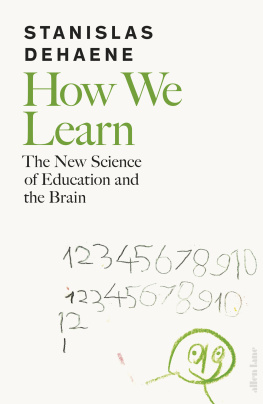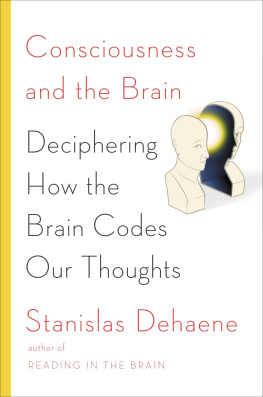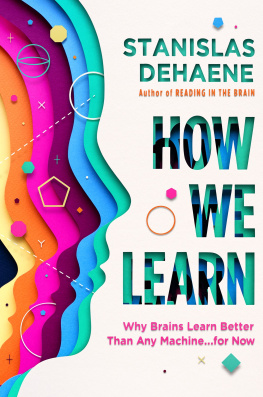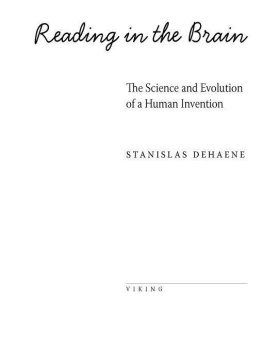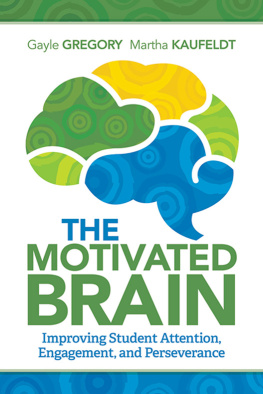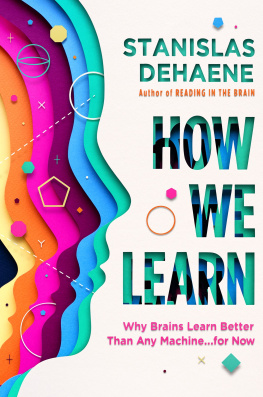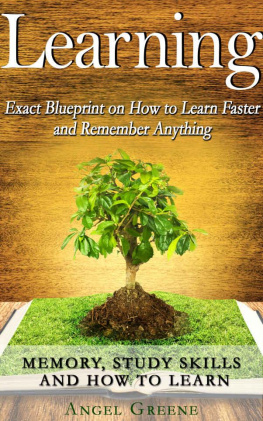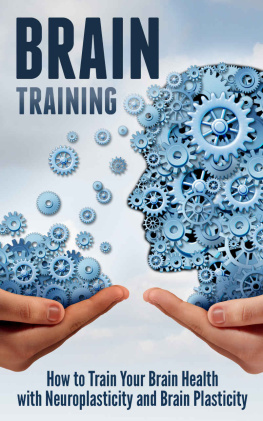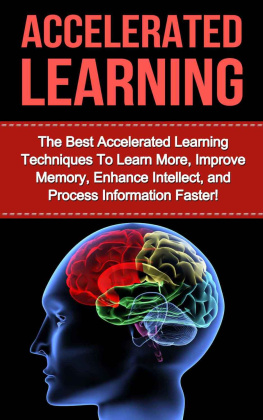Credits
INSERT CREDITS
: copyright by Nicols Sainz Trpaga. Reproduced with permission.
.
. Licensed under Creative Commons Attribution License CC-BY 4.0.
. Licensed under Creative Commons Attribution License CC-BY 4.0.
.
. Copyright 2008 by National Academy of Sciences, U.S.A.
, top left: courtesy of Fei Xu Lab.
, top right: courtesy of Moira Dillon and Elizabeth Spelke.
, top: courtesy of G. Dehaene-Lambertz and J. Dubois.
. Copyright 2006 by National Academy of Sciences, U.S.A.
: modified with permission from a figure provided courtesy of Leah Krubitzer. For review of the corresponding research, see Krubitzer, Leah. The Magnificent Compromise: Cortical Field Evolution in Mammals. Neuron, 56(2), 201208, (2007).
.
, bottom: courtesy of G. Dehaene-Lambertz and J. Dubois.
. Licensed under Creative Commons Attribution License CC-BY 4.0.
, top right: photo by David Habltzel from Pexels.
, bottom: reprinted with permission from Springer Nature. Nature. Hafting, Torkel, Marianne Fyhn, Sturla Molden, May Britt Moser, and Edvard I. Moser. Microstructure of a spatial map in the entorhinal cortex. Copyright 2005.
, top left and middle: copyright by Stanislas Dehaene.
.
.
.
.
, top: courtesy of G. Dehaene-Lambertz.
.
staff. Medical gallery of Blausen Medical 2014. WikiJournal of Medicine 1 (2), (2014). doi:10.15347/wjm/2014.010. Licensed under Creative Commons Attribution-ShareAlike 4.0 International License (CC BY-SA 4.0).
, bottom: from Kilgard, Michael P., and Michael M. Merzenich. Cortical Map Reorganization Enabled by Nucleus Basalis Activity. Science, vol. 279, issue 5357, (1998), pg. 17148. Reprinted with permission from AAAS.
.
. Licensed under Creative Commons Attribution License CC-BY 4.0.
.
.
INTERIOR CREDITS
, bottom: copyright by Stanislas Dehaene.
.
: copyright by Stanislas Dehaene.
.
, top right: courtesy of Philip Buttery.
, bottom right: copyright by Stanislas Dehaene.
: The Postnatal Development of the Human Cerebral Cortex, Volumes I-VIII, by Jesse LeRoy Conel, Cambridge, Mass.: Harvard University Press, Copyright 1939, 1941, 1947, 1951, 1955, 1959, 1963, 1967, by the President and Fellows of Harvard College. Renewed 1967, 1969, 1975, 1979, 1983, 1987, 1991.
.
.
, top: photo courtesy of Eric Knudsen.
. Copyright 2000 by the National Academy of Sciences, U.S.A.
, top: copyright 2001 by Michael Carroll. Reproduced with permission.
.
.
. Licensed under Creative Commons Attribution License CC-BY 4.0.
.
.
, top: copyright by Stanislas Dehaene.
.
.
.
. Copyright 2007 by Kaplan and Oudeyer. This is an open-access article subject to an exclusive license agreement between the authors and the Frontiers Research Foundation, which permits unrestricted use, distribution, and reproduction in any medium, provided the original authors and source are credited. Licensed under Creative Commons Attribution License CC-BY 4.0.
: copyright by Stanislas Dehaene.
Attribution 4.0 International (CC BY 4.0) can be found at https://creativecommons.org/licenses/by/4.0/.
Attribution-ShareAlike 4.0 International (CC BY-SA 4.0) can be found at https://creativecommons.org/licenses/by-sa/4.0/.
ALSO BY STANISLAS DEHAENE
Consciousness and the Brain:
Deciphering How the Brain Codes Our Thoughts
Reading in the Brain:
The New Science of How We Read
The Number Sense:
How the Mind Creates Mathematics
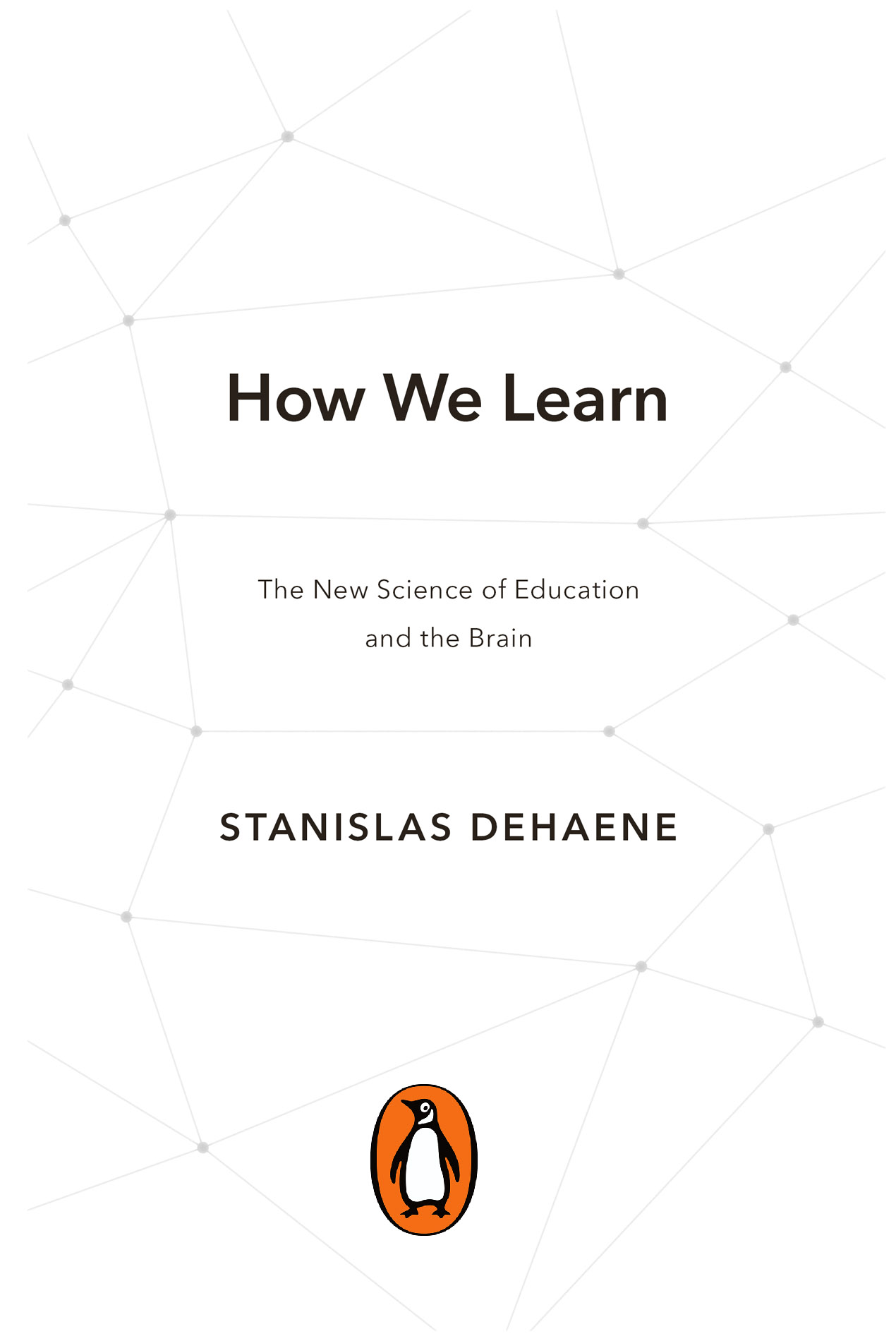
PENGUIN BOOKS
UK | USA | Canada | Ireland | Australia
India | New Zealand | South Africa
Penguin Books is part of the Penguin Random House group of companies whose addresses can be found at global.penguinrandomhouse.com.

First published in the United States of America by Viking, an imprint of Penguin Random House LLC 2020
First published in Great Britain by Allen Lane 2020
Copyright Stanislas Dehaene, 2020
Based on, in part, Apprendre!, published in France by Odile Jacob, Paris, in 2018.
constitute an extension to the copyright page
The moral right of the author has been asserted
Cover illustration by Tho
Author photograph by Patrick Delapierre/INSERM
ISBN: 978-0-241-36647-9
This ebook is copyright material and must not be copied, reproduced, transferred, distributed, leased, licensed or publicly performed or used in any way except as specifically permitted in writing by the publishers, as allowed under the terms and conditions under which it was purchased or as strictly permitted by applicable copyright law. Any unauthorized distribution or use of this text may be a direct infringement of the authors and publishers rights and those responsible may be liable in law accordingly.
For Aurore, who was born this year, and for all those who once were babies.
Begin by making a more careful study of your pupils, for it is clear that you know nothing about them.
Jean-Jacques Rousseau, Emile, or On Education (1762)
This is a strange and amazing fact: we know every nook and cranny of the human body, we have catalogued every animal on the planet, we have described and baptized every blade of grass, but we have left psychological techniques to their empiricism for centuries, as if they were of lesser importance than those of the healer, the breeder or the farmer.
Jean Piaget, La pdagogie moderne (1949)
If we dont know how we learn, how on earth do we know how to teach?
L. Rafael Reif, president of MIT (March 23, 2017)
Introduction
IN SEPTEMBER 2009, AN EXTRAORDINARY CHILD FORCED ME TO DRASTICALLY revise my ideas about learning. I was visiting the Sarah Hospital in Brasilia, a neurological rehabilitation center with a white architecture inspired by Oscar Niemeyer, with which my laboratory has collaborated for about ten years. The director, Lucia Braga, asked me to meet one of her patients, Felipe, a young boy only seven years old, who had spent more than half his life in a hospital bed. She explained to me how, at the age of four, he had been shot in the streetunfortunately not such a rare event in Brazil. The stray bullet had severed his spinal cord, thus rendering him almost completely paralyzed (tetraparetic). It also destroyed the visual areas of his brain: he was fully blind. To help him breathe, an opening was made in his trachea, at the base of his neck. And for over three years, he had been living in a hospital room, locked within the coffin of his inert body.
In the corridor leading to his room, I remember bracing myself at the thought of having to face a broken child. And then I meet Felipe, a lovely little boy like any other seven-year-oldtalkative, full of life, and curious about everything. He speaks flawlessly with an extensive vocabulary and asks me mischievous questions about French words. I learn that he has always been passionate about languages and never misses an opportunity to enrich his trilingual vocabulary (he speaks Portuguese, English, and Spanish). Although he is blind and bedridden, he escapes into his imagination by writing his own novels, and the hospital team has encouraged him in this path. In a few months, he learned to dictate his stories to an assistant, then write them himself using a special keyboard connected to a computer and sound card. The pediatricians and speech therapists take turns at his bedside, transforming his writings into real, tactile books with embossed illustrations that he proudly sweeps with his fingers, using the little sense of touch that he has left. His stories speak of heroes and heroines, mountains and lakes that he will never see, but that he dreams of like any other little boy.

